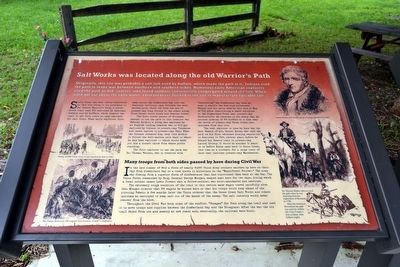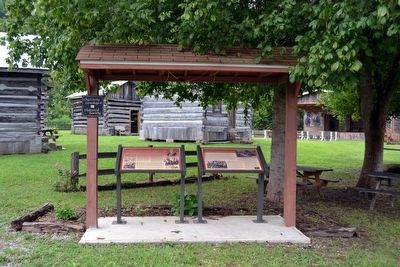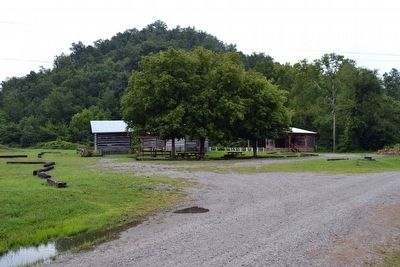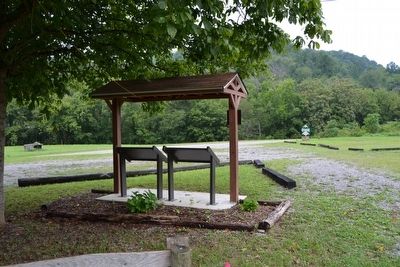Manchester in Clay County, Kentucky — The American South (East South Central)
Salt Works was located along the old Warrior's Path
Originally this site was probably a salt lick used by buffalo, which made the path to it. Indians used the path to make war between northern and southern tribes. Numerous early American explorers used the path as did hunters, who found animals conveniently congregated around the lick. When word got out about the salty water, entrepreneurs flocked to the site to manufacture valuable salt.
Salty water was most likely discovered at this site owning to its proximity to the famous Warrior’s Path, a north-south trail used for centuries by American Indians and by buffalo, which created the trail in the first place as they searched for salt licks. When early explorers first came across the Cumberland Gap into the Kentucky territory, they followed the well-marked path, which led from one end of present day Clay County to the other, along Otter Creek, Goose Creek and Sextons Creek.
The first known person of European descent to use the path in this location was Gabriel Arthur, a young man employed by an English trading company who in 1673 got captured by Indians in present-day Tennessee and taken captive to present-day Ohio. When the Indians released him, they told Arthur to follow the well-marked path back to where he had been captured – which would have put him a stone’s throw from where you’re standing.
The first explorer to use the path was Dr. Thomas Walker, who is credited with “discovering” the Cumberland Gap when he came to explore the Kentucky wilderness. Walker and his party came by this site in May of 1750 after constructing a small structure on the Cumberland River near present-day Barbourville. He recorded in his diary that he counted upwards of 100 buffalo at a lick near the present-day Paces Creek, just upstream from this site.
The next explorer to come by here was the most famous of all, Daniel Boone, who used the path on his first extended hunting expedition in Kentucky in 1769, several years before he blazed his famous trail in present-day Laurel County. It would be another 15 years or so before Boone came back to Goose Creek, this time as a surveyor for a large tract of land that included present-day Manchester.
Many troops from both sides passed by here during Civil War
In the late summer of 1862 a force of nearly 10,000 Union Army soldiers marched by here on their way from Cumberland Gap in a trek known to historians as the “Magnificent Retreat.” The army was fleeing from a superior force of Confederates that had surrounded them back at the Gap. The Union forces, commanded by Brig. General George Morgan, camped near here for two days, during which a local soldier named Lewis Stivers shot a fellow-soldier, was court-marshaled and executed.
The extremely rough condition of the trail in this section made wagon travel painfully slow. Gen. Morgan ordered that 100 wagons be burned here so that his troops could keep ahead of the pursuing Rebels. A few months later the Union ordered that the Goose Creek Salt Works and others upstream be destroyed to keep salt out of the hands of the enemy. The salt industry would never recover from the blow.
Throughout the Civil War both sides of the conflict “foraged” for food along the trail and use it to move troops and supplies between the Cumberland Gap and the Bluegrass. After the war the old trail faded from use and memory as new roads and, eventually, the railroad were built.
(Lower Right Drawing Caption)
Dr. Thomas Walker (above) used the path when he was returning from his exploration of Kentucky in 1750.
After the American Revolution the path was used by settlers like Clay County’s first resident, John Gilbert (right).
Topics. This historical marker is listed in these topic lists: Colonial Era • Exploration • Native Americans • War, US Civil. A significant historical year for this entry is 1673.
Location. 37° 8.768′ N, 83° 45.667′ W. Marker is in Manchester, Kentucky, in Clay County. Marker can be reached from Railroad Avenue south of Poplar Street
, on the right when traveling south. Marker is at the south end of Riverside Park next to the Goose Creek Salt Works Pioneer Village; the above directions are to the driveway entrance to the park. Touch for map. Marker is in this post office area: Manchester KY 40962, United States of America. Touch for directions.
Other nearby markers. At least 8 other markers are within 11 miles of this marker, measured as the crow flies. This Site is Birth Place of Local History (here, next to this marker); Gov. Bert T. Combs (1959-1963)/Bert T. Combs (1911 – 1991) (approx. half a mile away); County Named, 1806 (approx. half a mile away); Goose Creek Salt Works (approx. 1.7 miles away); A Masterful Retreat (approx. 1.7 miles away); Chief Red Bird (approx. 10 miles away); John Gilbert, Sr. Memorial Highway (approx. 10 miles away); Oneida Baptist Institute (approx. 10½ miles away). Touch for a list and map of all markers in Manchester.
Also see . . . Historic Goose Creek Salt Works Pioneer Village. Clay County Genealogical & Historical Society website entry (Submitted on March 28, 2022, by Larry Gertner of New York, New York.)
Credits. This page was last revised on March 28, 2022. It was originally submitted on August 29, 2015, by Duane Hall of Abilene, Texas. This page has been viewed 749 times since then and 94 times this year. Photos: 1, 2, 3, 4. submitted on August 29, 2015, by Duane Hall of Abilene, Texas.



